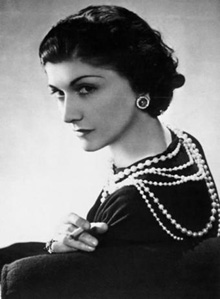Coco Channel - a French pioneer in women's fashion design
 In order to be irreplaceable one must always be different.-Coco Chanel
In order to be irreplaceable one must always be different.-Coco Chanel
Chanel introduced a sophisticated, minimalized look for women who had become, as she had, allergic to frilly, corsetted Belle Epoque costumes. Her uncomplicated jersey dresses, riding jackets, sweaters and - yes! - trousers became the dress uniform for women on their way to emancipation.
If you were to call up Coco Chanel's spirit at a seance and interrogate it, however, the grouchy, necklace-rattling gremlin would probably deny any such political agenda and disappear in a cloud of Gitanes. She designed only things she wanted to wear, and if a whole generation of women did too, well, that was fine.
Gabrielle Chanel was born in Saumur in 1883. Orphaned at a young age, her grandmother put her in a convent where, somehow, the saucy girl got the idea to become a dancehall artist. On the café-concert circuit, her trademark song was something called "Qui qu'a vu Coco", and the nickname stuck.
An elegant young man named Etienne Balsan rescued Coco from a tawdry diet of pancake makeup and burlesque, whisking her off to a mansion where she learned to ride horses and mix with the beau monde. With help from various moneyed lovers, Chanel opened boutiques on Paris's Rue Cambon and in the casino town of Deauville before World War I. Chanel would be among the first to acknowledge that it was the war that made her such a success. Despite the phrase "guns or butter", women kept on buying clothes, but they no longer wanted to be encumbered by lavish dresses. Propelled by her wartime popularity, Chanel refined her pared-down, androgynous look in the Roaring Twenties, earning the label, "soup-kitchen style." She chopped off her dark hair and started producing easy, dropped-hemline dresses, sleeveless evening gowns, and the famous Little Black Dress, paired with two-toned shoes. Chanel No. 5 came out in 1921, the perfume that Marilyn Monroe later famously said was the only thing she wore to bed.
The Second World War was not as fortuitous for Chanel as the First. She spent 1940-44 in Paris, arousing suspicions about her relations with the German occupation forces. When the war ended, Chanel left France for Switzerland.
This would have finished off most careers, but Chanel came out of retirement at the age of 71 and reopened her shop in Paris. The collarless, braid-trimmed suits in jersey and tweed come from this period. Though she had eschewed all jewellry in her younger days, now she loaded down her suits with bracelets and strands of pearls, indiscriminately mixing real and fake gems. The quilted leather handbag with the interlinked, back-to-back "C" clasp came out in 1955.
Coco Chanel died, alone, in the Ritz hotel on January 10, 1971. The Chanel house was left to slide for the next 12 years until Karl Lagerfeld took over in 1983. Lagerfield turned the house around, producing collections that pay tribute and occasionally poke fun at the Chanel look. In the 1991 spring collection, he showed sequined Chanel jackets in fluorescent colors with lycra leggings. He achieved enormous success in his fall/winter 1992-93 collection with his black leather biker style Chanel suit.
Source: CelebrityTrendz.com